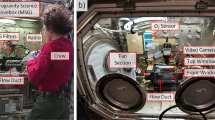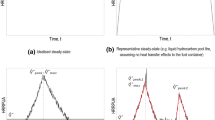Abstract
When a fire occurs in an aircraft cargo compartment, the fire plume will rise from a different location, intermittently or continuously impact the ceiling, and form a ceiling jet flame at varying heights. Meanwhile, the low-pressure environment within the cargo compartment has a great influence on flame height and high-temperature zone, which could lead to the violent development of ceiling jet fire. Based on this discussion, a series of square oil pan fires were conducted in a full-size cargo compartment located in Kangding airport (altitude 4250 m, atmospheric pressure 61 kPa). Fire behaviors, such as burning rate, flame temperature, flame heights, and smoke gas temperature distribution beneath the ceiling, were measured and analyzed. The experimental results show that as the effective ceiling height decreases, the burning rate of 30 cm square pan fires grows, with a sharp change in the low-pressure environment (50 kPa), where flames impinges on the ceiling. For 20-cm square pan fires, the burning rate at 50 kPa has the same trend with 30 cm, at 75 kPa looks like a parabolic plot, and at 101 kPa shows a continuous dropping. The centerline flame temperature decreases slowly along the axis when the fire occurs at higher height above the floor. Considering the influence of ambient pressure, effective ceiling height, and oil pan size, an empirical correlation for the ceiling transverse smoke temperature distribution is proposed by modifying the current models.









Similar content being viewed by others
Abbreviations
- \(H_{\text{ef}}\) :
-
Effective ceiling height (m)
- \(H\) :
-
Height of the cargo compartment (m)
- \(L_{\text{SP}}\) :
-
Square pan length (m)
- \(P_{\infty }\) :
-
Ambient pressure (kPa)
- \(T_{\infty }\) :
-
Ambient temperature (K)
- \(\dot{m}\) :
-
Burning rate (g s−1)
- \(\rho\) :
-
Air density (kg m–3)
- \(\dot{Q}\) :
-
Total release rate (kW)
- \(A\) :
-
Oil pool area (m2)
- \(R\) :
-
Ideal gas constant (8.31 J K−1 mol−1)
- \(C_{\text{p}}\) :
-
Specific heat capacity (kJ kg−1 K−1)
- \(g\) :
-
Gravity acceleration (m2 s−1)
- \(b\) :
-
Ceiling plume radius (m)
- \(T_{0}\) :
-
Ceiling temperature at flame impingement position (K)
- \(T_{\text{r}}\) :
-
Ceiling temperature at the horizontal distance of \(r\) from the impingement position (K)
- \(\Delta T_{\text{r}}\) :
-
Ceiling temperature rise at the horizontal distance of \(r\) from the impinging position (K)
- \(\Delta T_{0}\) :
-
Ceiling temperature rise at flame impingement position (K)
- \(\Delta H_{\text{c}}\) :
-
Combustion heat (kJ kg−1)
- \(C_{\upalpha}\) :
-
Air entrainment coefficient
- \(A_{\text{c}}\) :
-
Temperature attenuation coefficient ration
References
Wikipedia. Aviation accidents and incidents. https://en.wikipedia.org/wiki/Aviation_accidents_and_incidents.
CSRTG Aircraft Accident Database, Chamber Safety Research Technical Group. 2016.
Federal Aviation Administration Fire Safety. https://www.fire.tc.faa.gov/Research/Background.
Zhang HD, Zheng XP. Characteristics of hazardous chemical accidents in China: A statistical investigation. J Loss Prev Proc. 2012;25:686–93.
Zhao J, Huang H, Wang H, et al. Experimental study on burning behaviors and thermal radiative penetration of thin-layer burning. J Therm Anal Calorim. 2017;130(2):1153–62.
Alpert RL. Calculation of response time of ceiling-mounted fire detectors. Fire Technol. 1972;8(3):181–95.
Alpert RL. Turbulent ceiling-jet induced by large-scale fires. Combust Sci Technol. 1975;11(5–6):197–213.
You HZ, Faeth GM. Ceiling heat transfer during fire plume and fire impingement. Fire Mater. 1979;3(3):140–7.
Fan CG, Zhang JQ, Zhu KJ, et al. An experimental study of temperature and heat flux in a channel with an asymmetric thermal plume. Appl Therm Eng. 2017;113:1128–36.
Wan H, Ji J, Li K, et al. Effect of air entrainment on the height of buoyant turbulent diffusion flames for two fires in open space. Proc Combust Inst. 2017;36(2):3003–10.
Wan H, Gao Z, Ji J, et al. Experimental study on ceiling gas temperature and flame performances of two buoyancy-controlled propane burners located in a tunnel. Appl Energy. 2017;185:573–81.
Gao ZH, Liu ZX, Wan HX, et al. Experimental study on longitudinal and transverse temperature distribution of sidewall confined ceiling jet plume. Appl Therm Eng. 2016;107:583–90.
Ji J, Fu Y, Li K, et al. Experimental study on behavior of sidewall fires at varying height in a corridor-like structure. Proc Combust Inst. 2015;35(3):2639–46.
Liu J, Chen M, Lin X, et al. Impacts of ceiling height on the combustion behaviors of pool fires beneath a ceiling. J Therm Anal Calorim. 2016;126(2):881–9.
Liu Q, Ma Q, Zhang H, et al. Experimental study on n-heptane pool fire behavior under dynamic pressure in an altitude chamber. J Therm Anal Calorim. 2017;128(2):1151–63.
Zhou Z, Wang J, Liu J, et al. Effect of the ambient pressure on the heat release rates of n-heptane pool fires. J Therm Anal Calorim. 2016;126(3):1727–34.
Tu R, Fang J, Zhang YM, et al. Effects of low air pressure on radiation-controlled rectangular ethanol and n-heptane pool fires. Proc Combust Inst. 2013;34(2):2591–8.
Tu R, Zeng Y, Fang J, et al. Low air pressure effects on burning rates of ethanol and n-heptane pool fires under various feedback mechanisms of heat. Appl Therm Eng. 2016;99:545–9.
Zhou Z, Wei Y, Li H, et al. Experimental analysis of low air pressure influences on fire plumes. Int J Heat Mass Transf. 2014;70(1):578–85.
Hu X, He Y, Li Z, et al. Combustion characteristics of n-heptane at high altitudes. Proc Combust Inst. 2011;33(2):2607–15.
Hu L, Wang Q, Delichatsios M, et al. Flame height and lift-off of turbulent buoyant jet diffusion flames in a reduced pressure atmosphere. Fuel. 2013;109:234–40.
Ma Q, Liu Q, Zhang H, et al. Experimental study of the mass burning rate in n-Heptane pool fire under dynamic pressure. Appl Therm Eng. 2017;113:1004–10.
Li C, Yao Y, Tao Z, et al. Influence of depressurized environment on the fire behaviour in a dynamic pressure cabin. Appl Therm Eng. 2017;125:972–7.
Niu Y, He Y, Hu X, et al. Experimental study of burning rates of cardboard box fires near sea level and at high altitude. Proc Combust Inst. 2013;34(2):2565–73.
Li Z, He Y, Zhang H, et al. Combustion characteristics of n-heptane and wood crib fires at different altitudes. Proc Combust Inst. 2009;32(2):2481–8.
Liu J, He Y, Zhou Z, Yuen R, Wang J. Investigation of enclosure effect of pressure chamber on the burning behavior of a hydrocarbon fuel. Appl Therm Eng. 2016;101:202–16.
Singh SP, Singh J, Saha K. Measurement and analysis of physical and climatic distribution environment for air package shipment. Packag Technol Sci. 2015;28(8):719–31.
McCaffrey BJ. Purely buoyant diffusion flames: Some experimental results. Final Report. Chemical and Physical Processes in Combustion. The National Institute of Standards and Technology (NIST), Miami Beach; 1979. p. 49.
Wang J, Lu S, Guan Y, et al. Experiment investigation on the influence of low pressure on ceiling temperature profile in aircraft cargo compartment fires. Appl Therm Eng. 2015;89:526–33.
Wang J, Lu S, Hu Y, et al. Early stage of elevated fires in an aircraft cargo compartment: a full scale experimental investigation. Fire Technol. 2015;51(5):1129–47.
Heskestad G, Delichatsios MA. The initial convective flow in fire. In: Symposium (international) on combustion. Elsevier; 1979. vol 17, no 1, p. 1113–23.
Funding
This work was partially supported by National Key R&D Program of China (No. 2017YFC0803300), National Natural Science Foundation of China (Grant No: U1633203) and the R&D project of Civil Aviation Administration of China (Grant No: 20,160,103).
Author information
Authors and Affiliations
Corresponding author
Rights and permissions
About this article
Cite this article
Tao, Z., Yang, R., Li, C. et al. Experimental study on liquid fire behavior at different effective ceiling heights in a full-size simulated cargo compartment. J Therm Anal Calorim 133, 1617–1626 (2018). https://doi.org/10.1007/s10973-018-7204-0
Received:
Accepted:
Published:
Issue Date:
DOI: https://doi.org/10.1007/s10973-018-7204-0




